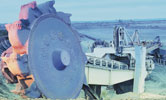

Background
Mine tailings are the crushed and milled rock residue that remains after mineral extraction. These tailings must be deposited for storage in a cost effective way that also meets environmental guidelines and mandates. Dams, dumps, and other types of surface piling are some of the more common tailings deposition methods used today. However, these all pose serious environmental concerns, as tailings often contain trace and sometimes substantial quantities of the metals found in the host ore, as well as certain amounts of chemicals and compounds used in the mining processes. As a result, establishing and maintaining tailings dumps represent a significant cost for mining companies.
A New Strategy: Tailing reprocessing
Historically, mineral separation processes have been somewhat inefficient because after the required crushing, grinding and metallurgical treatment, some amount of valuable metal is left behind in the residue. But recently, improved mining technologies and the ever-increasing price of gold in the marketplace have opened the opportunity for mining companies to purchase old mining dumps and treat the tailings in order to recover residual gold. South African miner Mintails is currently focused on exploring, evaluating, and processing hundreds of millions of tons of surface gold bearing tailings in the Witwatersrand area of South Africa. These types of gold reclamation efforts are never 100% efficient, and automation and control plays a significant role in improving the metallurgical processes. With the help of systems integrator Opto Controls, each month Mintails is collecting significant amounts of the valuable metal. In the process, the company is positively impacting the environment by clearing away mountainous, land consuming, and unsightly dumps.
Opto Controls
Opto Controls has been a supplier and integrator of hardware and software for industrial automation, remote monitoring, and data acquisition applications for more than 10 years. Specialising in solutions utilising Opto 22 components and systems, Opto Controls’ broad project and industry expertise includes access control and security, print production monitoring, and factory automation. Company president Mike Harrison and process control and programming engineer Adam Carless, head a team contracted by Mintails to assemble and configure an automation system for Mintails’ Mogale Sands Plant This system connects to, monitors, controls and acquires data from a large assortment of field devices, equipment, and instrumentation and also manages the many mechanical and chemical processes used to remove the gold from the tailings.
The Opto Controls system’s key components are Opto 22 rack mount and standalone programmable automation controllers (PACs) and I/O housed in containers located at various areas of a processing plant situated between the gold mine and the dump. “Initially, these controllers were to be networked via fibre-optic cable, but Mintails management later decided to go with a wireless solution from MikroTik so as to avoid having to dig trenches and lay conduit for the cabling,” explains Harrison. The MikroTik platform features a Linux-based operating system, omnidirectional antennas, and wireless communication capabilities utilising all four of the 802.11 standards (a/b/g/n), as well as frequency ranges within the industrial, scientific and medical (ISM) radio bands. The system also has meshing capabilities, data transfer speed of up to 350 Mbps, and a range that easily bridges the average distance (about 150 metres) between the Mogale site controllers.
Readers wanting to find out more about the Opto Controls solution architecture for the Tailings Processing System can visit: http://instrumentation.co.za/+C14002
For more information contact Mike Harrison, Opto Controls, +27 (0)11 792 5232, [email protected], www.opto.co.za
| Tel: | +27 11 792 3560 |
| Email: | [email protected] |
| www: | www.opto.co.za |
| Articles: | More information and articles about Opto Controls |
© Technews Publishing (Pty) Ltd | All Rights Reserved